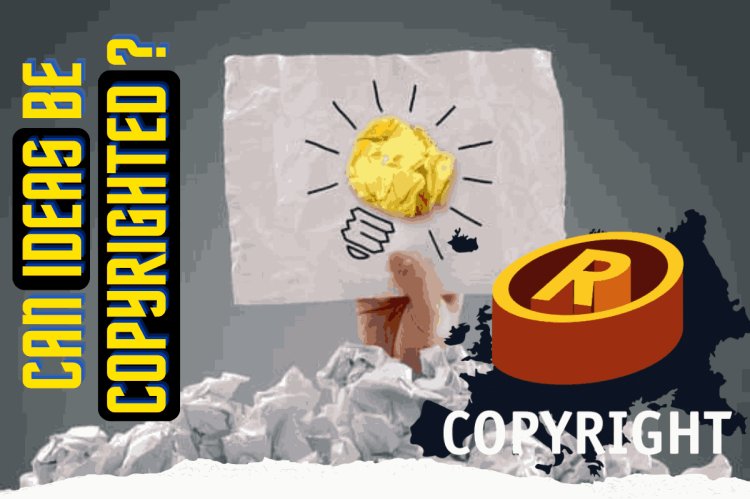Can Ideas be Copyrighted?
This article debunks the myth of copyrighting ideas. It clarifies that copyright protects the expression of ideas, not the ideas themselves. The distinction is crucial for fostering creativity and innovation. The article explores the Merger Doctrine, a legal principle that applies when the expression becomes indistinguishable from the idea. Challenges and limitations of copyright law are discussed, including the subjectivity of the "abstraction test" and the potential stifling of innovation. The importance of striking a balance between protecting expression and fostering innovation is emphasized. Finally, the article concludes by highlighting the need for a deeper understanding of copyright to encourage creativity and safeguard intellectual property.

Introduction:
In the realm of intellectual property (IP), a common misconception arises: the right of copyright of ideas. This notion, often perpetuated in casual conversation, can create confusion and hinder the innovation process. This article aims to provide a clear understanding of copyright law and its role in protecting creative expression, dispelling the myth of the copyrighted idea. We will explore the critical distinction between an abstract concept and its tangible manifestation, while introducing the legal mechanisms that safeguard the fruits of human ingenuity. By delving into the intricacies of IP law, we will illuminate the tools available to protect a wide range of creative endeavors, from literary masterpieces to ground-breaking software code. This newfound knowledge will empower individuals to confidently unleash their creative potential, understanding that the true value lies not in copyrighting the spark of inspiration, but in giving form to the unique expression of that idea.
Understanding Copyright Protection:
At its core, copyright protection grants exclusive rights to the creators of original works. However, this protection extends only to the tangible expressions of those ideas, not the abstract ideas themselves. The Indian Copyright Act, like its counterparts in many countries, delineates various categories of protected works. These include literary works (novels, poems, etc.), dramatic works (plays, screenplays, etc.), musical compositions, artistic creations (paintings, sculptures, etc.), cinematographic films, and sound recordings. Notably absent from this list is any explicit mention of ideas. This gap has led to judicial interpretation and the development of legal doctrines that clarify the boundaries of copyright protection.
Copyright Protects Expression, Not Ideas:
Copyright law serves a crucial purpose: it safeguards the expression of ideas rather than the ideas themselves. While copyright prevents unauthorized copying of original works, it does not confer exclusive rights over the underlying concepts. This distinction is fundamental to fostering creativity and innovation. It ensures the free flow of ideas in the public domain, allowing others to build upon existing concepts and contribute to the advancement of knowledge. Imagine a world where copyright protection stifled the ability to write stories based on the concept of love or create new inventions based on the idea of the wheel. Progress would stagnate.
Challenges and Limitations: The Merger Doctrine
The line between idea and expression can sometimes become blurry. There are instances where ideas can only be conveyed in a specific manner. In such scenarios, copyrighting the expression would effectively equate to copyrighting the underlying idea, potentially impeding the free exchange of ideas. To address these situations, courts often invoke the Merger Doctrine. This legal principle aims to determine when ideas and expressions become indistinguishable, thereby negating copyright protection.
A classic example of the Merger Doctrine in action is the case of Morrisey v. Proctor & Gamble Co. Here, the court deliberated on whether the rules of a competition or contest were subject to copyright. It concluded that the idea of the contest merged with its specific rules, rendering them inseparable. Copyrighting the rules would essentially amount to copyrighting the core idea of the contest, thus precluding copyright protection.
Similarly, in Joshua Et-Hokin v. Skyy Spirits Inc., the issue revolved around photographs of Skyy Spirits' iconic blue bottle. The court ruled that since there are limited ways to photograph a standard bottle, the pictures lacked originality and therefore eligibility for copyright protection.
However, it's important to acknowledge the potential limitations of such rulings. Consider the example of photographing a bottle. While it may seem like a straightforward task, no two photographers capture the exact same image. Variations in angles, lighting, and background can result in significant differences. In such instances, the idea-expression dichotomy fails to provide a clear-cut solution, highlighting the limitations of this legal concept.
Beyond the Idea-Expression Dichotomy: Criticisms and Considerations
While copyright law serves as a vital tool for incentivizing creativity and innovation, critiques arise regarding its limitations in protecting certain forms of expression. One criticism focuses on the subjectivity of the "abstraction test" used in cases like Nichols v Universal Pictures Corp. This test determines whether two works exhibit substantial similarity, a key factor in copyright infringement claims. The subjective nature of this test can lead to inconsistencies in rulings. Additionally, concerns arise over the potential stifling of creativity if copyright protection extends too broadly. Overly broad protection might hinder the free exchange of ideas, potentially discouraging others from building upon existing works.
Finding the right balance between protecting creative expression and fostering innovation remains a challenge. Copyright law is a complex and ever-evolving field. As new forms of creative expression emerge, the conversation surrounding the copyrightability of ideas will likely continue.
Conclusion
The misconception surrounding the copyrightability of ideas can be a significant hurdle for aspiring creators. Understanding the core purpose of copyright law – to protect the expression of ideas, not the ideas themselves – empowers individuals to channel their creativity into tangible works. While the line between idea and expression can sometimes be blurry, legal doctrines like the Merger Doctrine offer frameworks for navigating these complexities.
However, copyright law is not without its limitations. The subjectivity inherent in tests like the "abstraction test" and the potential for stifling innovation through overly broad protection highlight the need for ongoing dialogue. As technology advances and new forms of creative expression take shape, the boundaries of copyright protection will undoubtedly continue to evolve.












